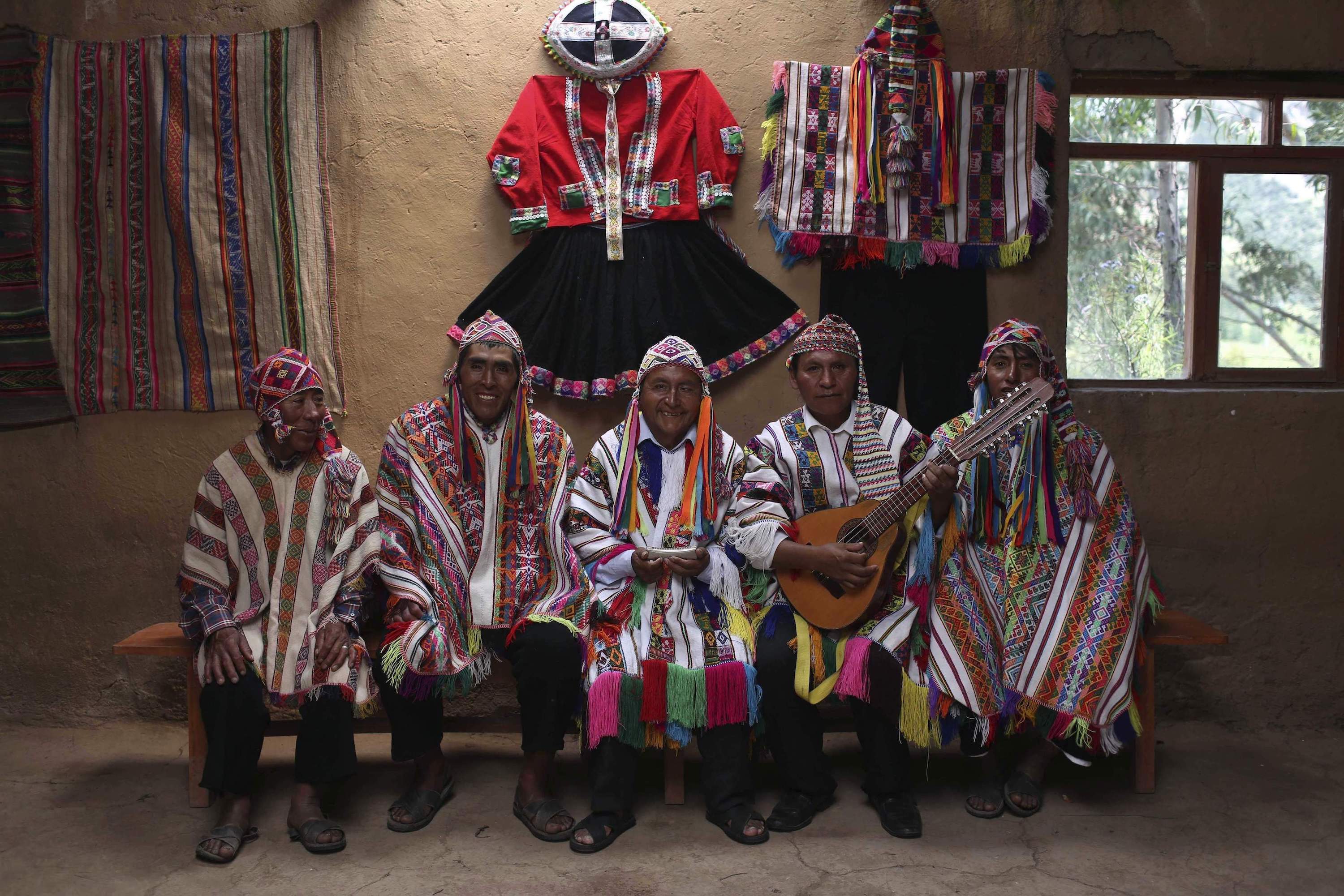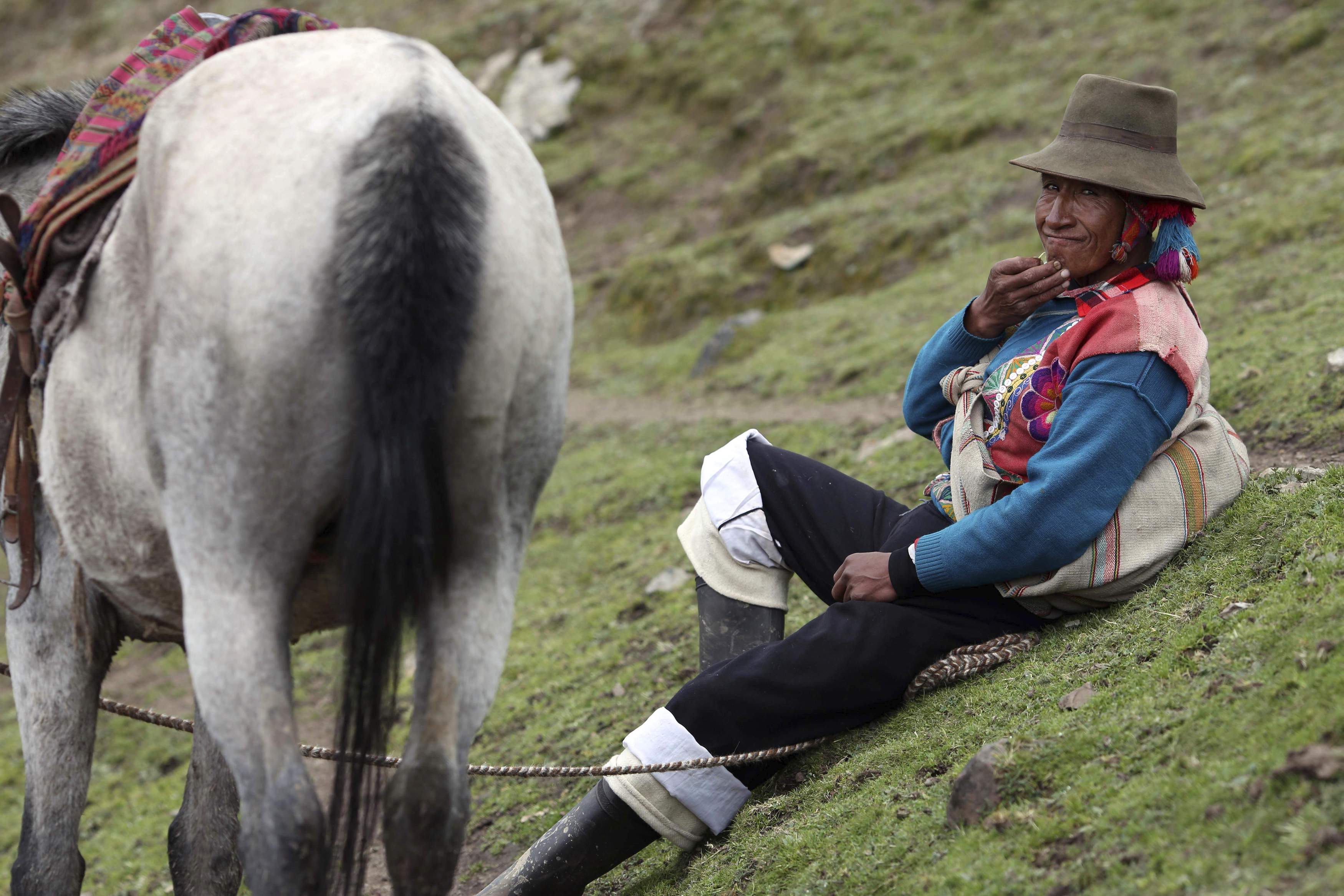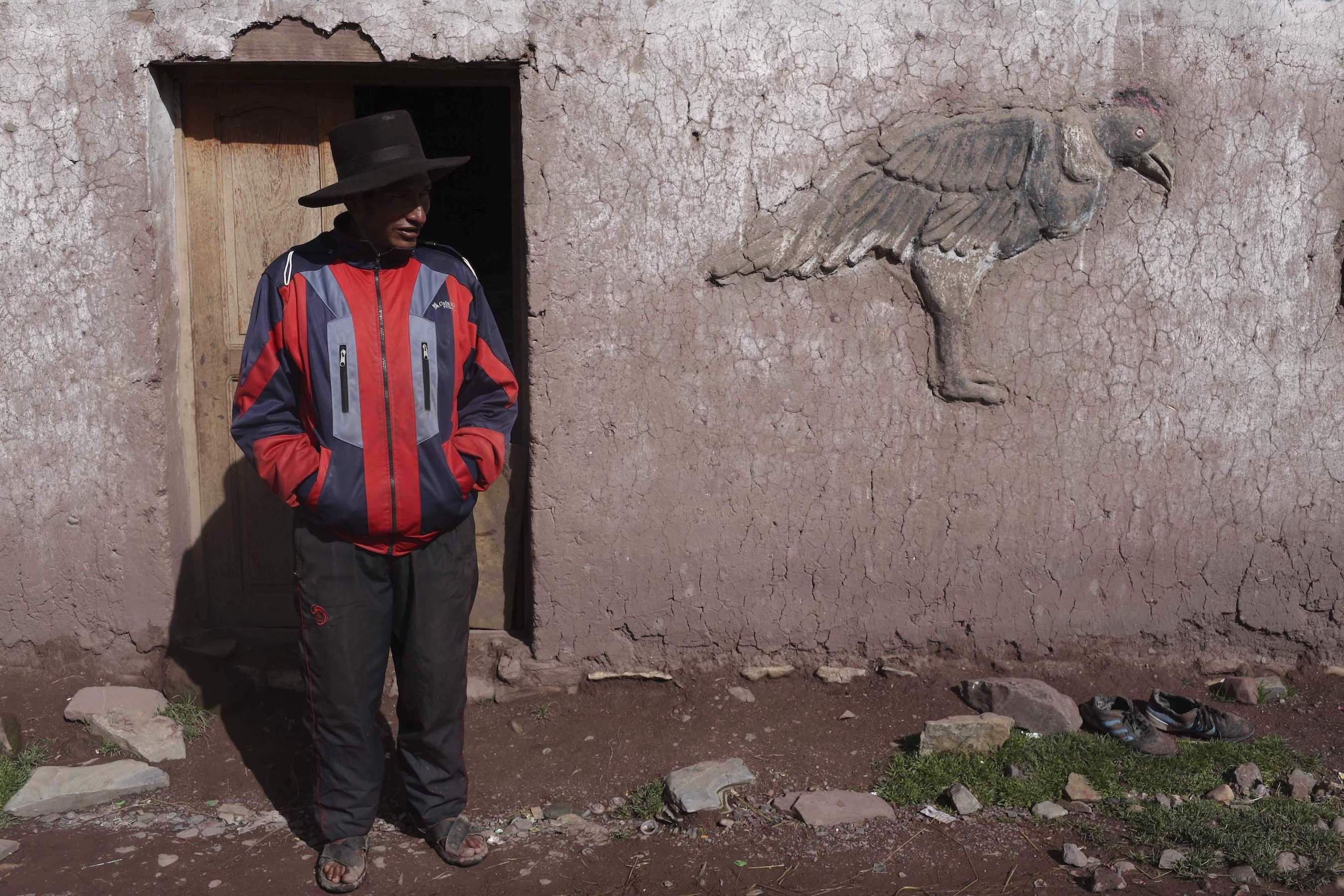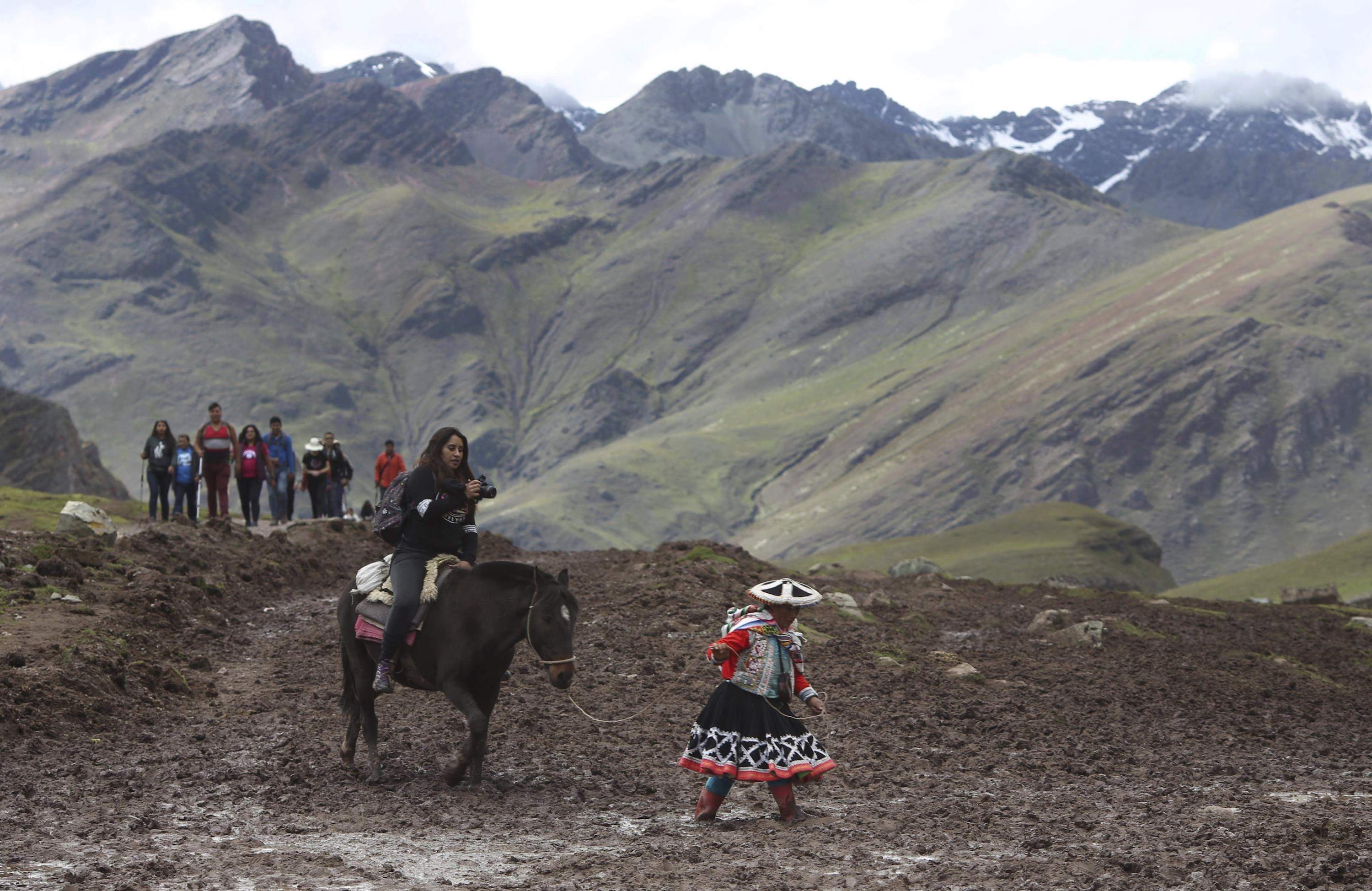観光客たちは、息も切れ切れに、2時間かけて海抜1万6,004フィート(5,000m)のペルー・アンデスの尾根まで登る。彼らは疲れ切っていたが、目の前に展開する魔術的な美に誰もが驚嘆した。
数百万年、地殻プレート同士の衝突による隆起で形成された色とりどりの堆積層の尾根。一面に広がるトルコグリーンとラベンダーとゴールドの縞模様は、『レインボーマウンテン』の名で知られるようになった。ペルーを訪れるバックパッカーが急増する中で、この自然の神秘が世界的に知られるようになり、『必ず行くべき場所』にランキングされるまでになったのはここ5年のことだ。
「写真で見るとフォトショップ加工かと思いますが、実物そのままですよ」。メキシコから来た18歳のルカス・リネン氏は言った。

AP Photo / Martin Mejia
毎日最大1,000人もの観光客を惹きつけるレインボーマウンテン。この地の人気は、貧しいアルパカ飼いたちの暮らすこの僻地に、非常に実りある経済効果をもたらした。その一方で、環境保護を訴える人々は、この地の開発を計画する鉱山会社の存在に加え、観光客たちまでが、この貴重な景観を破壊する要因になると危惧している。
「生態学的に見て非常に価値のある地域を、彼らはみすみす破壊しています」。そう語ったのは、ペルーの生物学者、ディナ・ファルファン氏だ。彼はインカの遺跡・マチュピチュから数時間ほどのこの地域で、存続が危ぶまれる野生生物の研究を行ってきた。
その証拠として彼は、レインボーマウンテンを目指す観光客が登ったため、過去18カ月の間にひどく浸食がすすんで景観が損なわれてしまった長さ2.5マイル(4キロ)の土道を例に挙げた。また、渡りをするアヒルたちがかつて好んだ湿地帯も、今では、5つのサッカー場ほどの広さの駐車場に様変わりしてしまった。ここは毎朝、主にヨーロッパやアメリカからやってくる観光客を運ぶバンで一杯になる。
- AP Photo / Martin Mejia
- AP Photo / Martin Mejia
- AP Photo / Martin Mejia
- AP Photo / Martin Mejia
そして、それよりも深刻な脅威も存在する。
カナダの鉱山会社カミーノ・ミネラルズ・コーポレーションは、レインボーマウンテンを含む、鉱物資源が豊富なこの地域の鉱業採掘権をすでに申請している。AP通信は同社に対し、開発計画に関するコメントを求めたが、同社は回答しなかった。
とはいえ、新たに押しよせる観光客が、アルコール中毒の蔓延や栄養失調、アルパカウール価格の下落に苦しんできたパンパチリ地方の先住民コミュニティに、雇用と現金収入をもたらしているのも事実だ。この地の住民の多くは、伝統的な遊牧生活をすでに放棄し、アマゾン地域での危険な金採掘の仕事に従事してきた。
現在彼らは、先祖伝来の土地への入場料として観光客からひとり3ドルを徴収し、年間約40万ドルの収益を上げている。この目覚ましい収益は、新たな観光ブームの恩恵に浴さない近隣の貧困自治体との税金争議の引き金にもなった。
観光客の急増にともない、地元住民は、地域環境と新たな来客たちの良き管理者としての責任も問われるようになった。しかしパンパチリのコミュニティリーダーのガビーノ・ウアマン氏は、万全な対応の用意はまだないと認めている。
「我々は英語を一言も話せませんし、万一の事故の際の応急処置もできません」。
多くの課題があるものの、過去2年間で、およそ500人の元村人がこの地に戻ってきた。その目的は、彼らの先祖も行ってきた、アンデスをまたいだ商品輸送の仕事に就くこと。ただし過去と違うのは、現在彼らが馬で運ぶのは、物資ではなく観光客だという点だ。
6人のキャンプ仲間が殺害された後、金の採掘業を離職したイサック・キスペ氏(25)は、「(レインボーマウンテンの人気は)まさに天の恵みです。」と語った。実家に戻った彼は馬を購入、観光客を山上に運ぶ仕事に従事し、去年1年で5,200ドルを稼いだ。
ガイドたちは、カラフルなウールの衣装とつばの広い伝統の帽子を身にまとい、馬を先導する。

AP Photo / Martin Mejia
生物学者のファルファン氏は、パンパチリのコミュニティが、ペルー国内のその他の持続可能な観光事業の試みから学ぶことを期待する、と語った。
たとえば、レインボーマウンテンを初めて世界に紹介した近郊の町チルカの観光事業は、まさにファルファン氏の言う「持続可能な」成功例だ。
この地でアルパカの放牧を営むあるグループが、過去10年近くにわたり、急速に溶解がすすむアウサンガテ氷河の周囲を5日かけてめぐるハイキングツアーの一環として、観光客の小グループをレインボーマウンテンまでつつましく案内していた。ところがインターネット投稿された人目を引く美しい写真の影響で、その秘密は時とともに世界の人々の知るところなったのである。
現在チルカのアルパカ飼いたちは、ユーカリの木で造った4棟のロッジを管理する。1棟あたりの収容人数は最大16名。照明はろうそくの明かりのみだが、お湯は使える。
ここに到着したゲストには、アルパカの革とウールで作った靴が贈られる。夜明けにゲストを眠りから穏やかに覚ますのは、ロッジの管理人オルランド・ガルシア氏が歌いあげるケチュア語のラブ・ソングだ。

AP Photo / Martin Mejia
「お客様が何を望んでいるのか、常に想像しながらお世話すれば、彼らは必ず満足してくれます」。ガルシア氏は語る。「海抜1万6,404フィート(5,000m)近いこの地で、最大限のくつろぎをお届けできたらと思っています」。
—
By FRANKLIN BRICENO, Associated Press
PITUMARCA, Peru (AP)
Tourists gasp for breath as they climb for two hours to a peak in the Peruvian Andes that stands 16,404 feet (5,000 meters) above sea level. They’re dead tired, but stunned by the magical beauty unfurled before them.
Stripes of turquoise, lavender and gold blanket what has become known as “Rainbow Mountain,” a ridge of multicolored sediments laid down millions of years ago and pushed up as tectonic plates clashed. It’s only within the last five years that the natural wonder has been discovered by the outside world, earning it must-see status on Peru’s burgeoning backpacker tourist circuit.
“You see it in the pictures and you think it’s Photoshopped — but it’s real,” said Lukas Lynen, an 18-year-old tourist from Mexico.
The popularity of Rainbow Mountain, which attracts up to 1,000 tourists each day, has provided a much-needed economic jolt to this remote region populated by struggling alpaca herders. Environmentalists, however, fear the tourists could destroy the treasured landscape, which is already coveted by international mining companies.
“From the ecological point of view they are killing the goose that lays the golden eggs,” said Dina Farfan, a Peruvian biologist who has studied threatened wildlife in the area just a few hours from the Incan ruins of Machu Picchu.
As proof, he points to a 2.5-mile (4-kilometer) dirt trail climbed by tourists to reach Rainbow Mountain that has been badly eroded in the last 18 months, scarring the otherwise pristine landscape. A wetland once popular with migrating ducks has also been turned into a parking lot the size of five soccer fields that fills each morning with vans of mostly European and American visitors.
There are more serious threats, too.
Camino Minerals Corp., a Canadian-based mining company, has applied for mining rights in the mineral-rich area that includes the mountain. The company did not respond to a request by The Associated Press for comment on its plans.
Yet the flood of tourists has meant jobs and hard cash for the local Pampachiri indigenous community, which has struggled with high rates of alcoholism, malnutrition and falling prices of wool for their prized alpaca. Many have abandoned nomadic life for dangerous gold mining jobs in the Amazon.
Now, they charge tourists $3 each to enter their ancestral land, netting the community roughly $400,000 a year — a small fortune that has triggered a tax battle with an impoverished, nearby municipality, which has seen no part of the windfall.
The surge in tourists also comes with a responsibility to be good stewards of the environment and their new guests, and Pampachiri community leader Gabino Huaman admits he is not sure they are ready to fully handle it.
“We don’t know one word in English,” he said. “Or first aid.”
Despite the challenges, roughly 500 villagers have returned in the last couple of years to take up their ancestral trade of transporting goods across the Andes. The difference is that now they are hauling tourists on horseback.
“It’s a blessing,” said Isaac Quispe, 25, who quit his job as a gold miner after six of his camp mates were murdered. He returned home and bought a horse that last year earned him $5,200 hauling tourists uphill.
The guides dress in colorful woolen clothes and wide-brimmed, traditional hats to lead the horses.
Farfan, the biologist, said he hopes the Pampachiri can learn from other sustainable tourism endeavors in Peru.
It was the success of one such project, in the nearby town of Chillca, that first put Rainbow Mountain on the map.
For much of the past decade, a group of shepherds had been quietly taking small groups of tourists to the mountain as part of a five-day hike around the fast-melting Ausangate glacier. Over time, and thanks to the stunning photographs posted on the internet, the secret got out.
Today the shepherds of Chillca manage four lodges made of eucalyptus wood with a capacity for 16 tourists each. They are lighted only by candle, but have hot water.
Arriving guests are given shoes made of alpaca leather and wool. At dawn, lodge-keeper Orlando Garcia gently awakens his guests with a love song performed in the Quechua language.
“You always have to be guessing what the client wants, and take care of it so you don’t lose their smile,” Garcia says. “We want them to feel the greatest comfort at almost 16,404 feet.”
—
By FRANKLIN BRICENO, Associated Press
PITUMARCA, Peru (AP)







